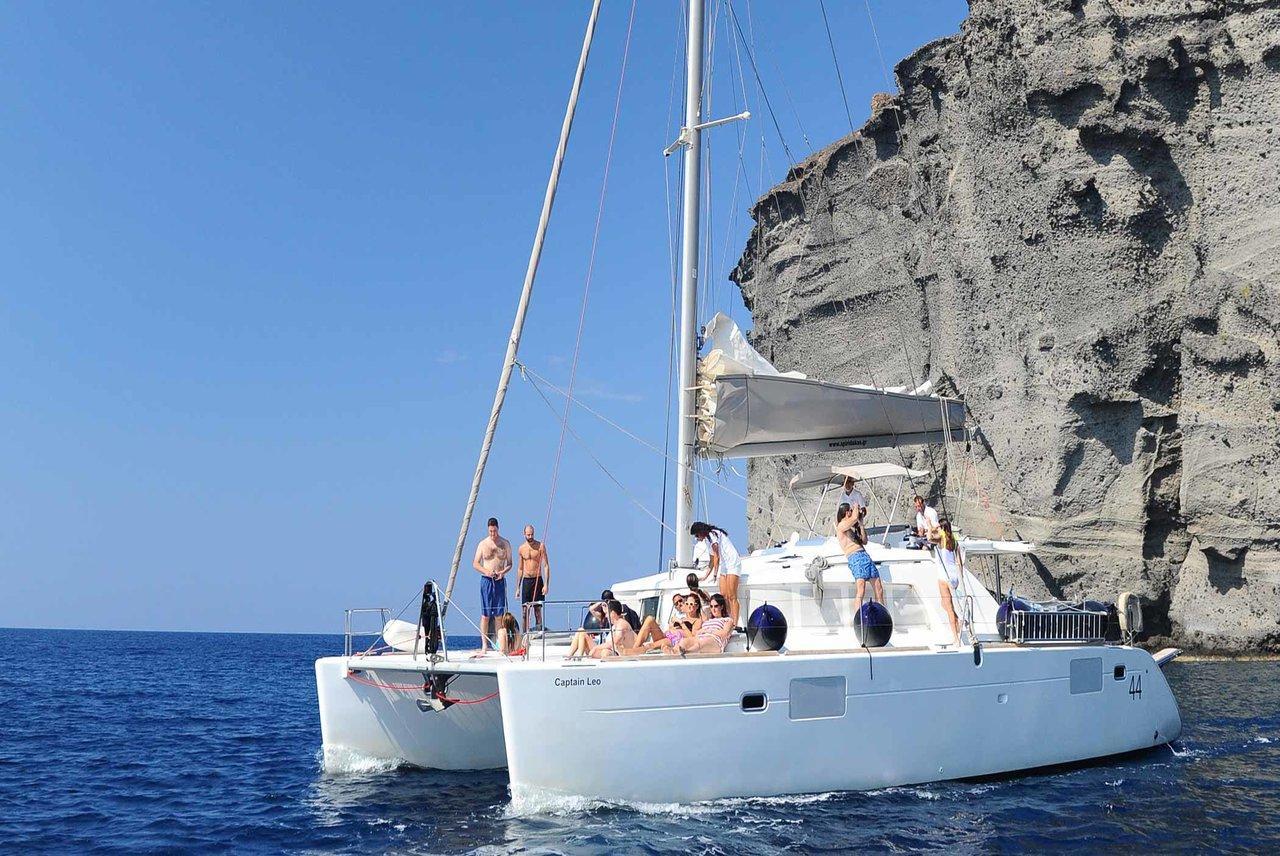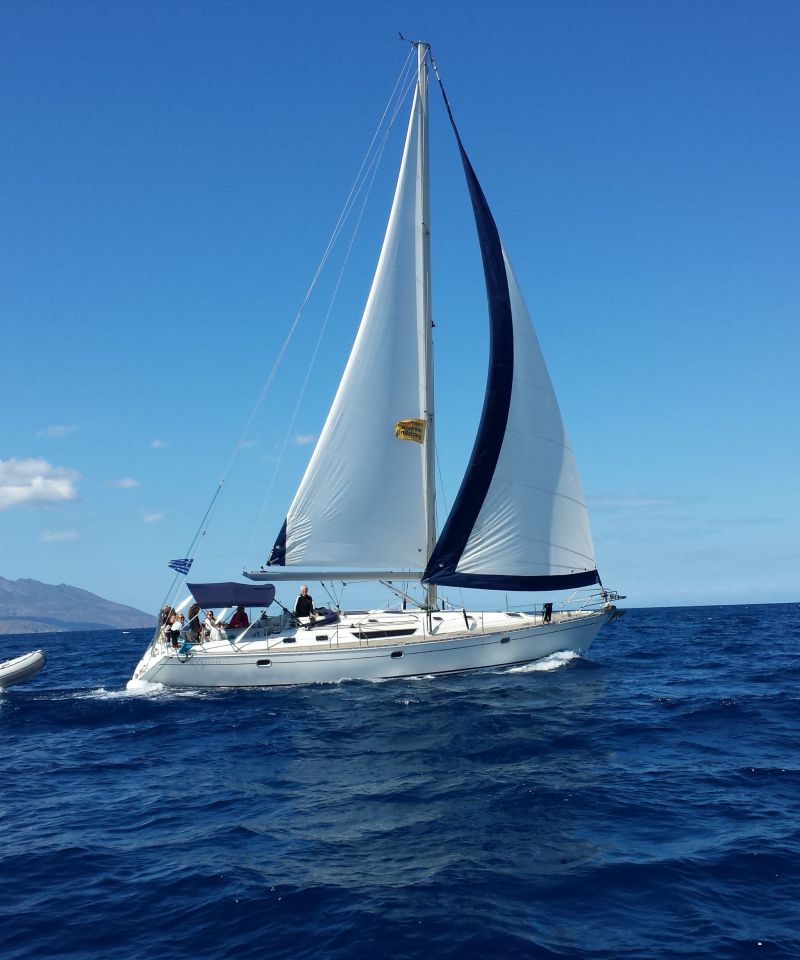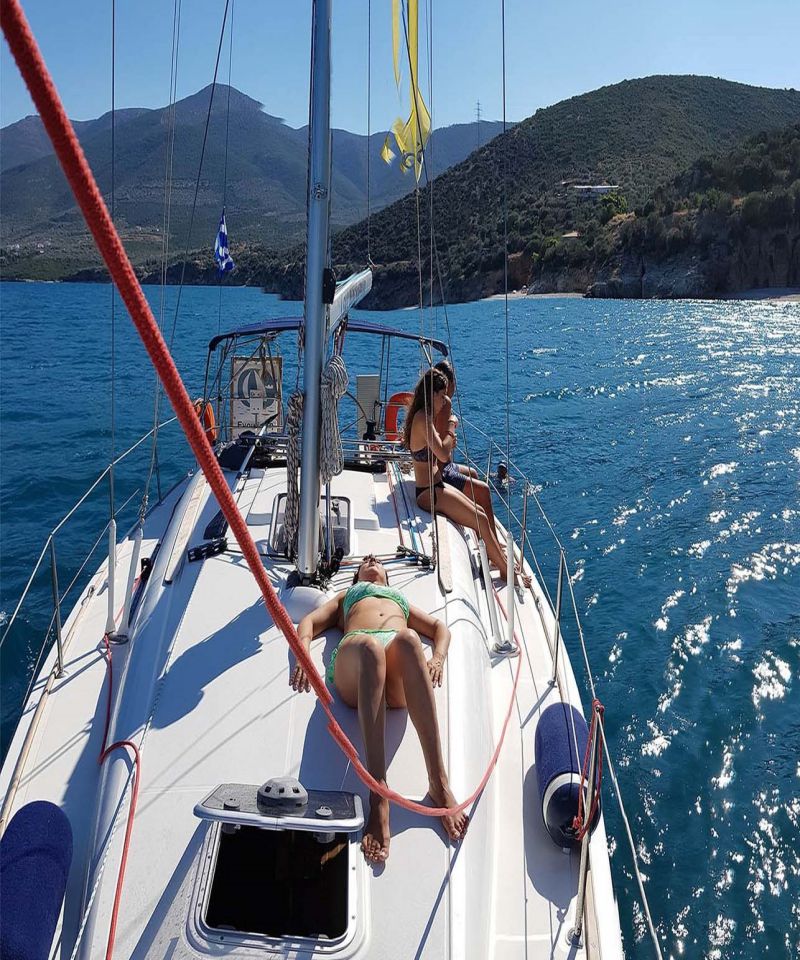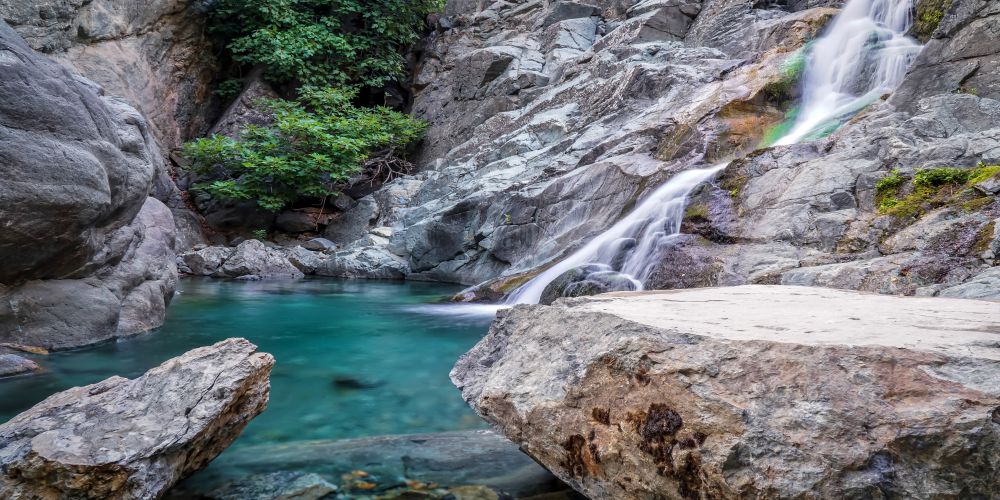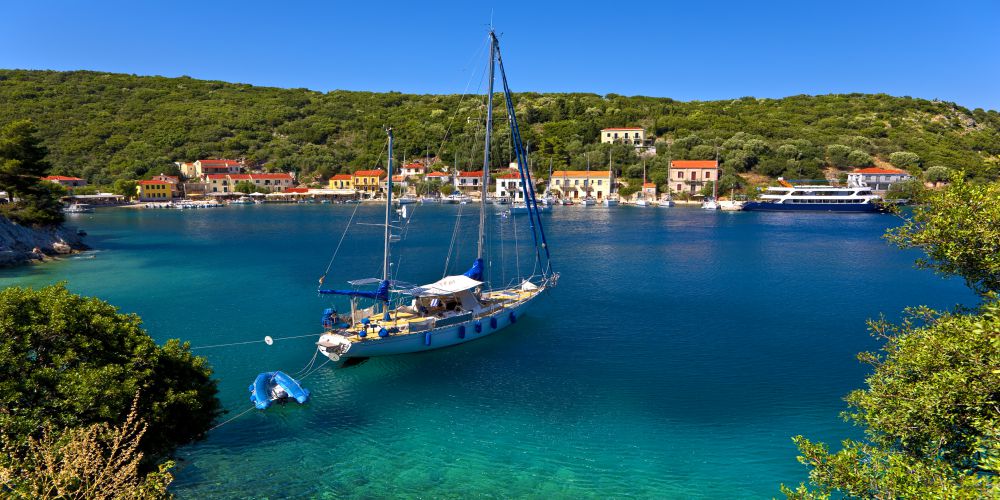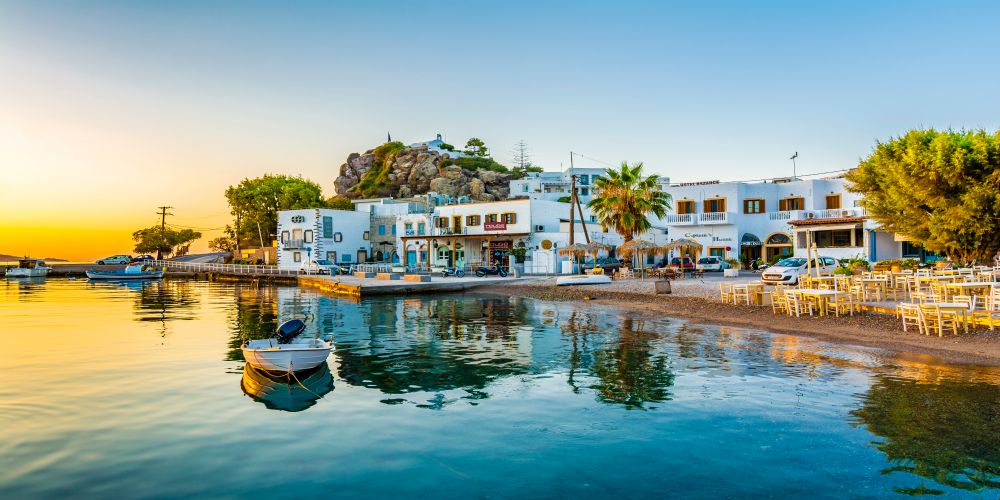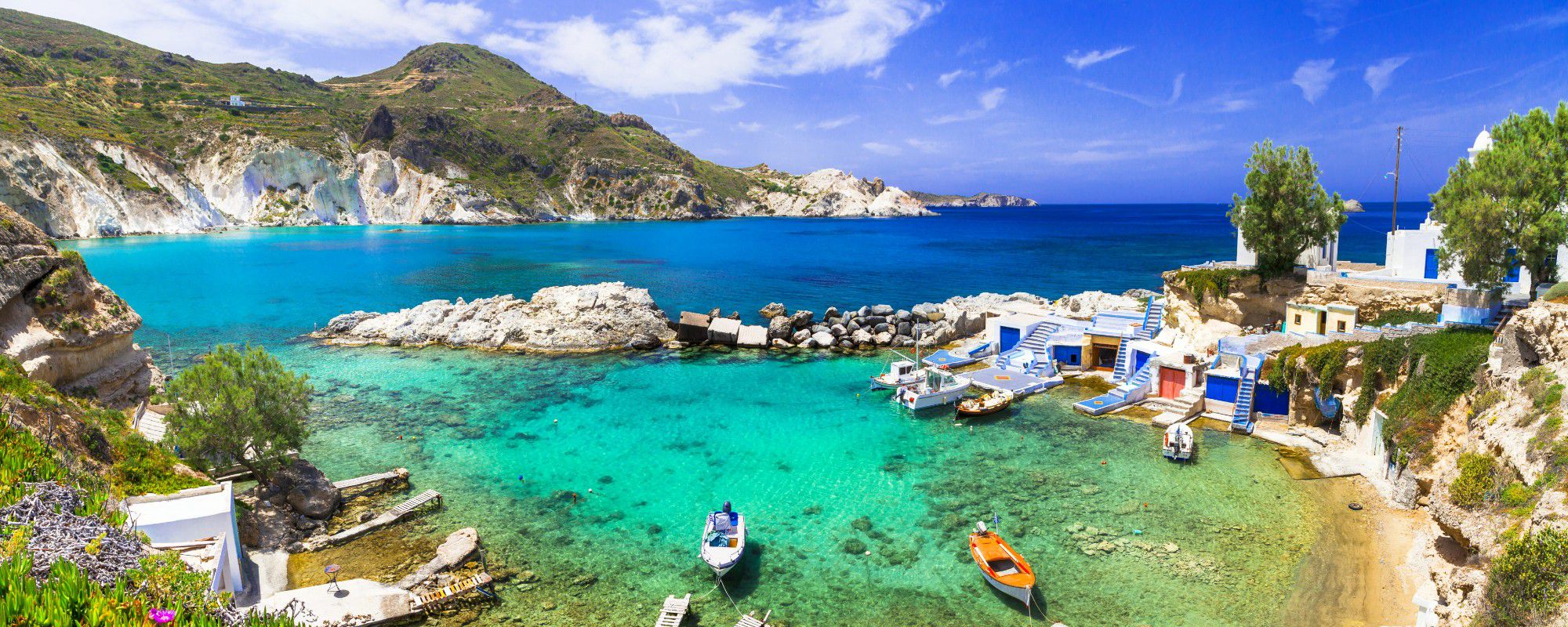
Milos Island: a Travel Guide
Key Takeaways
- Milos Island is known for its fantastic natural beauty, including breathtaking beaches and unique volcanic rock formations.
- Plaka, the traditional capital of the island, offers picturesque alleys and stunning sunset views.
- The Archaeological Museum of Milos showcases the island's rich history, including artifacts from its prehistoric and Roman periods.
- Exploring sites like Klima, the catacombs of Trypiti, and the Milos Mining Museum offers a glimpse into the island's fascinating past and geological significance.
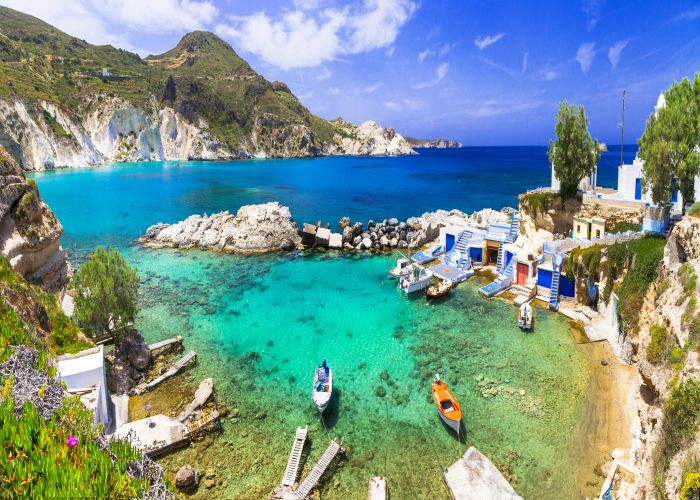
Milos is the southwesternmost Cycladic island of the Aegean Sea with a fantastic natural beauty, including marvelous beaches and idyllic sceneries even other Greek islands are jealous of.
Let us introduce you to the small but full of wonders island of Milos, a place to satisfy your wanderlust.
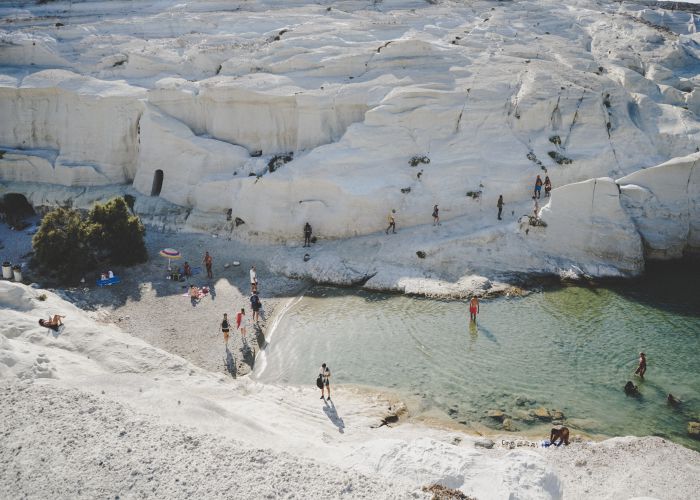
Milos Island is home to some of the most iconic sceneries the Aegean region has to offer.
By being a volcano -today considered to be in a dormant state- the particular geology of the island adds to its beauty with extraordinary volcanic rock formations and rich marine wildlife.
Here are the things you should definitely not miss on your trip to Milos to live your Greek experience to its fullest!
Things to do on Milos Island
Wander around Plaka
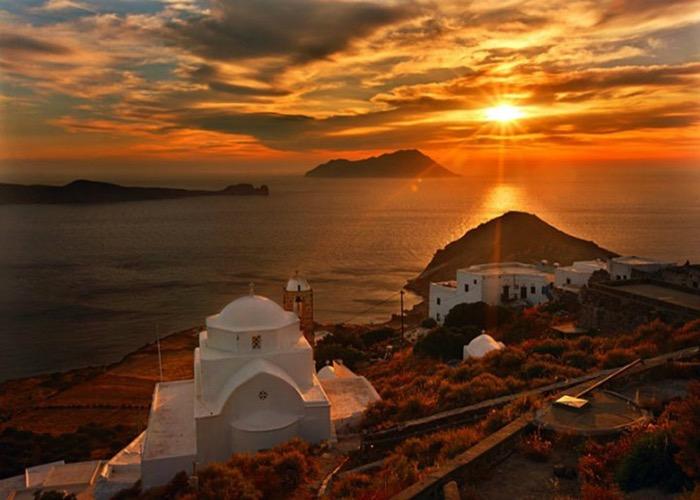
The settlement of Plaka is built on top of a small hill overlooking the entrance of the Melian Gulf. Some 5 km north of the port of Adamas, it is the traditional capital of the island really close to some of the most beautiful beaches available.
Plaka was founded in the 13th century after the Venetian occupation. The Venetians, realizing the importance of its location, decided to build a castle, declaring this way their dominance and securing the port of the island.
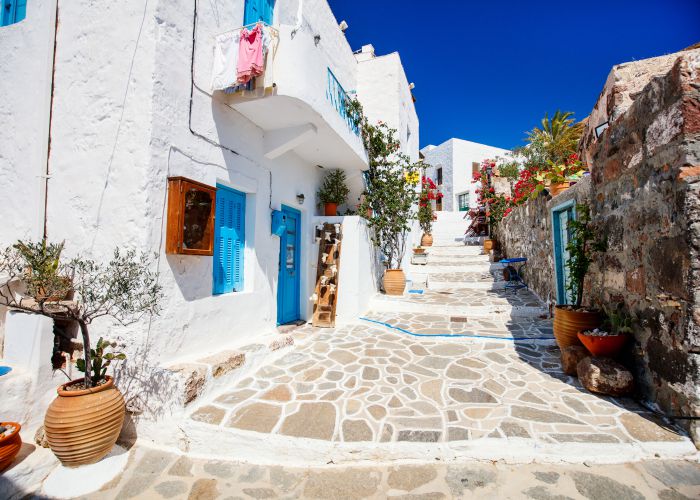
After some years of resistance, the Melians started accepting Venetian rule. They settled around the castle, forming the main town that was going to be the economic, social, and cultural center for the years to come.
This came to an end during the coming centuries because of the uprise of piracy that ravaged the Aegean Sea. Melians had to abandon their capital and head inland, creating another settlement only to come back to Plaka in the 18th century.
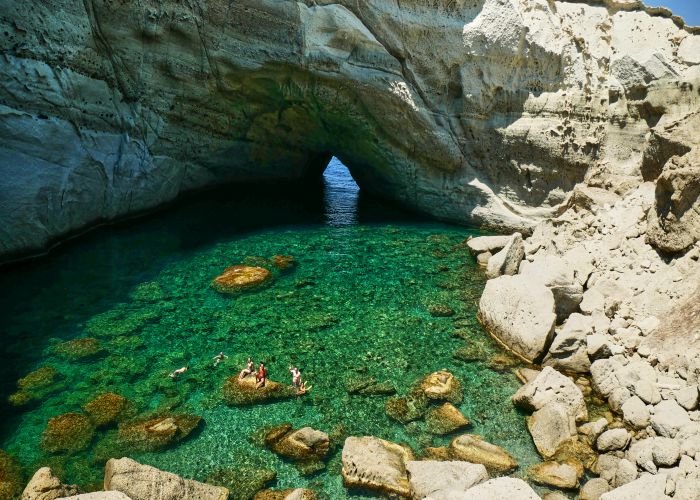
Today, the visitor has the chance to wander around one of the most picturesque traditional towns of the Cyclades with an authentic vibe that will definitely enchant you.
Choose to have a walk in the evening when Plaka really comes to life, and try to find a spot to enjoy the sunset.
Visit the Archaeological Museum of Milos
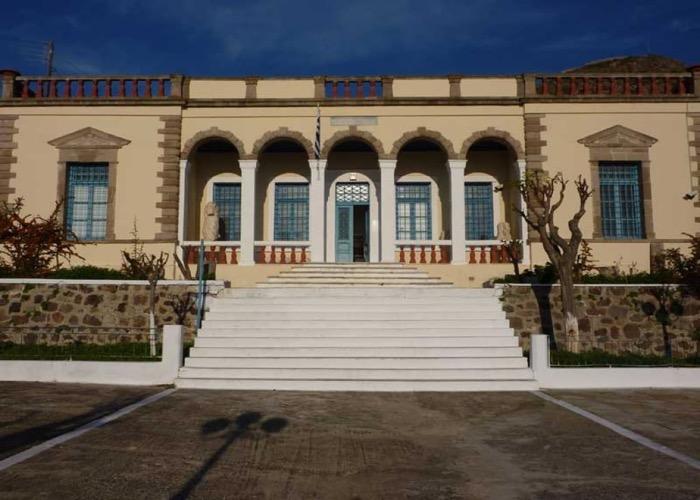
Archaeological Museum of Milos - credits: milos.gr
Located in the town of Plaka, the Archaeological Museum of Milos is one of the most impressive provisional museums in Greece.
Hosted in a neoclassical building of the 19th century, designed by the famous architect Ernst Ziller, it includes artifacts reflecting the vast history of the island.
Milos was always an important power in the Greek world that faced different phases of prosperity. During prehistoric times, the abundance of obsidian found on the island led to an economic boom, constituting Milos as a pivotal trading center covering almost all of the Mediterranean Sea.
Blades of Melian obsidian are found in large quantities throughout the eastern Mediterranean region, proving Milos' trading significance.
Even after the invention of bronze making, Milos continued to play an important role in the Aegean Sea with settlements such as the one of Phylakopi, excavated by the British Archaeological School of Athens at the end of the 19th century.
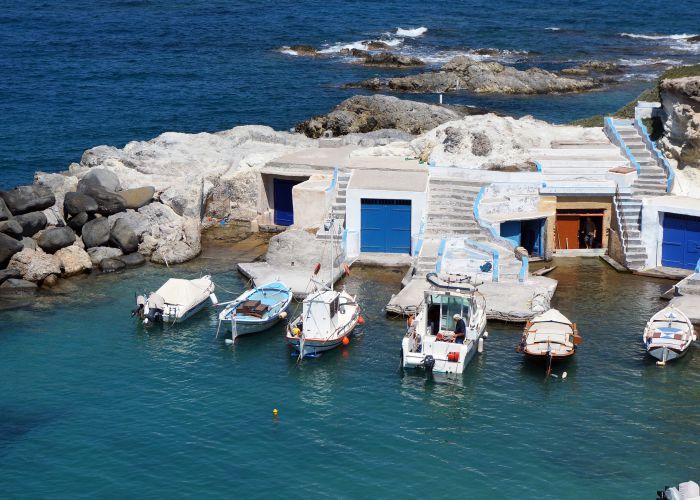
The findings of the site indicate a thriving settlement with high standards of living, contesting the contemporary centers of Crete or Thera.
Most of the artifacts found there are on display at this small museum, while others, such as the fresco of the Flying Fish, are now exhibited at the National Archaeological Museum in Athens.
Up until Roman times, Milos made a huge artistic and cultural contribution to Greek culture, providing some of the finest examples of sculpture surviving from the ancient world.
Some of them are the world-renowned statue of Venus de Milo in the Louvre, the statue of Asclepius at the British Museum, and the statue of Poseidon in Athens.
Discover the small port of Klima
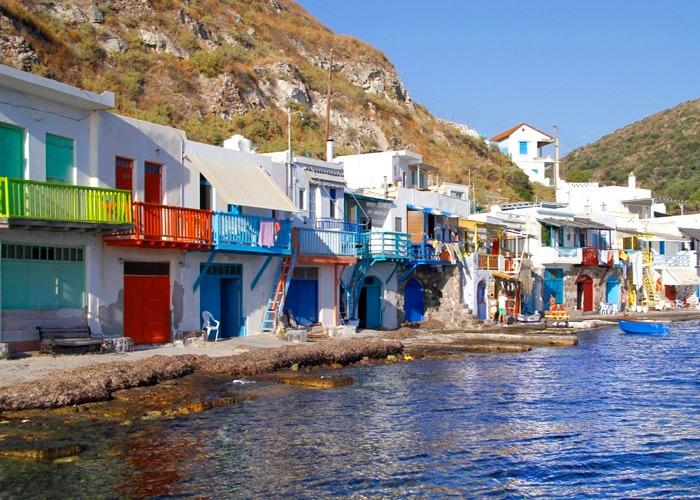
At the very mouth of the Melian Gulf lies the small port of Klima. Nowadays, the inhabitants of this small fishing village are very few, but their occupation used to be its driving force. Walk on the small port and gaze at the little two-story houses facing the sea.
The ground levels of those houses typically have large arched entrances for the fishermen to store their boats if the weather is rough. During antiquity, this was the location of Dorian city (1100-800 BC), one of the most important sites on the island.
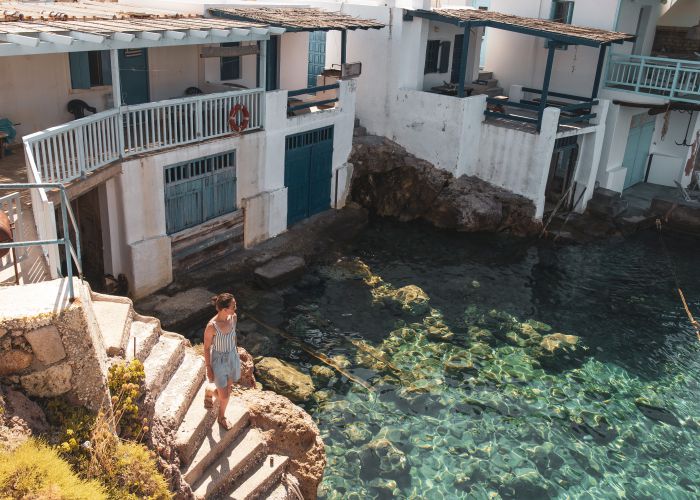
The whole area around Klima is of high archaeological and historical interest, with two acropolises, parts of the ancient walls, ruins of the Roman and ancient theatre, the site of Venus de Milo discovery, and many traditional paths that will time-travel you back to Milos’ past!
Explore the catacombs of Trypiti
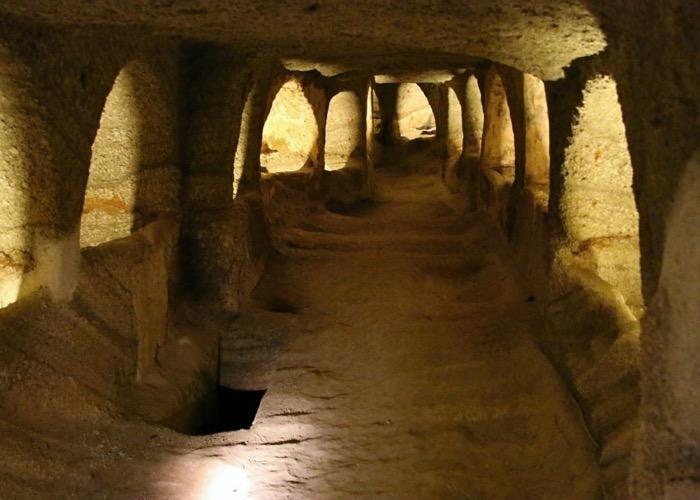
Perhaps the most impressive site of Milos is the early Christian catacombs close to the modern village of Trypiti.
After the challenge of the old pagan religion and the dominance of Christianity, the early Christian Melians buried their dead, according to the customs of that time, in catacombs.
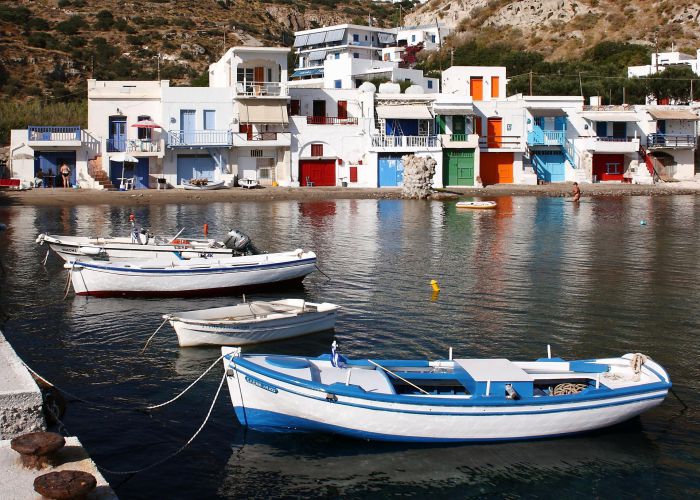
Covering a time span of more than five centuries (1st-6th AD), the visitor has the chance to sneak a peek at this transitional time period that shaped the modern world.
Walk through a tunnel system of about 200 meters and see from up close the burial sites of Melians dug into the soft volcanic rock and decorated with lively frescoes.
Discover Milos Mining Museum
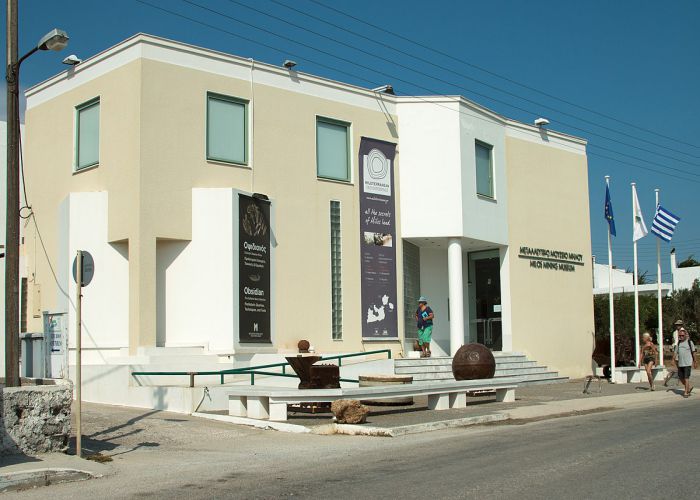
Inextricably linked to the general historical course of the island, mining activity began on Milos during the Neolithic era, in 8000 BC.
Thanks to the volcanic origin of the island, the soil of Milos has a unique mineral wealth. Over the centuries, their extraction and marketing for various uses have developed significantly.
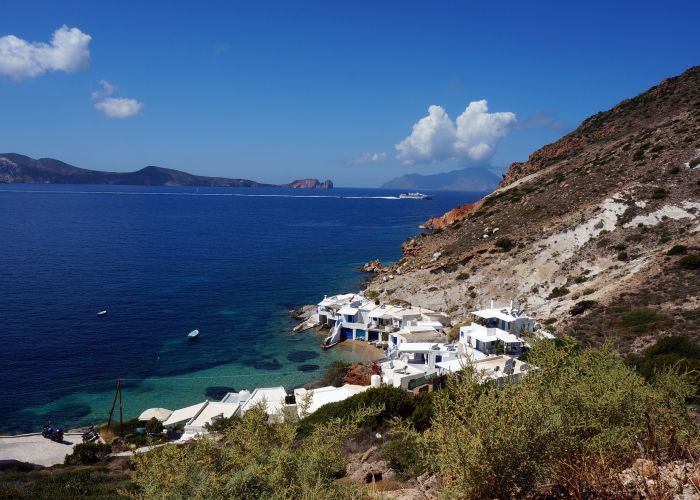
The Mining Museum of Milos opened its gates in 1998 in Adamas in a two-story building.
The main axis of the exhibits is the man and his contribution to the mining activity through rich photographic material, videos, and information about the way of extraction, while presentations of the modern mining activity are presented.
The exhibits of the museum also include a large tribute to the mineral wealth of Milos, with samples of minerals and information on their uses.
Get to know the island's natural beauty
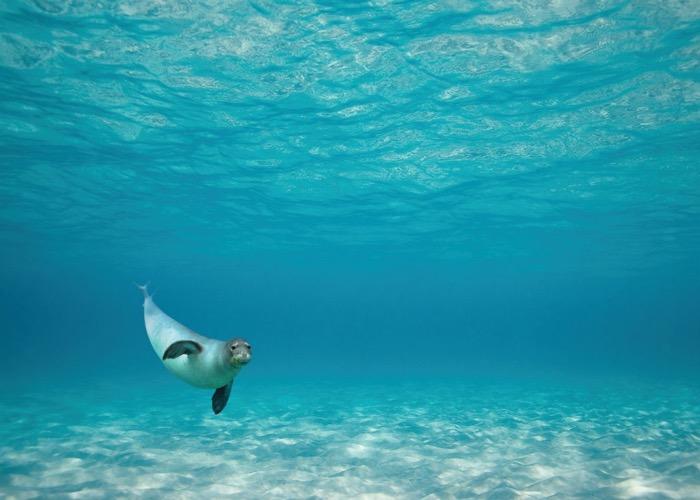
More than half of the island's territory is protected as a natural park and belongs to the Natura 2000 network.
The island operates as a stop between Europe and Africa. Therefore, many migratory bird species choose to rest on the island, contributing to its biodiversity.
Due to the volcanic past of Milos, its territory is full of indigenous plant species nowhere else to be found, and its hills and mountains are home to small mammals, the red viper, and the very rare goat of Antimilos. Marine life is also abundant on the island.
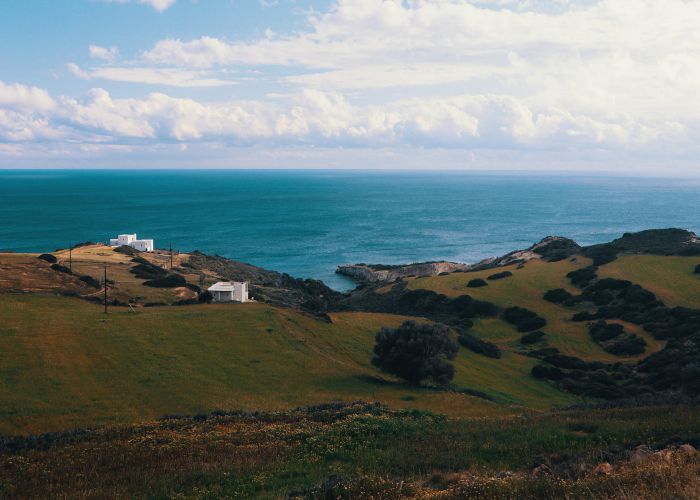
The numerous coves, bays, and caves create one of the last remaining habitats of the endangered species of the Mediterranean monk seal.
On Milos, you will have the chance to learn more about the seals monachus-monachus and if you are really lucky, you might see one in its natural habitat.
Take a boat trip around the island and marvel at the Aegean sea
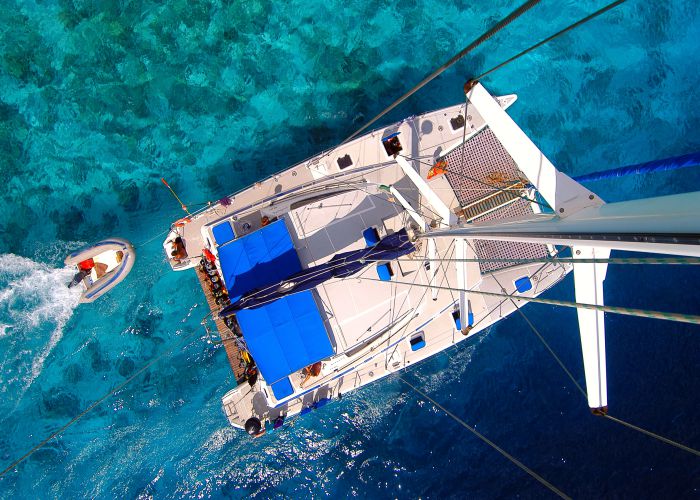
It is no secret that all Greek islands boast incredible coastlines, which a boat trip will reveal. Who wouldn't want to swim on incredible beaches that are not accessible in any other way than by sea? You're just a boat trip away from the dream!
With a boat rental or a sailing adventure, you will get to admire the coastline and swim in crystal clear waters you wouldn't be able to reach otherwise.
Not to mention that a sailing trip in Milos is one of the most luxurious experiences you can enjoy on the island.
Visit the neighboring Greek islands of Milos, Greece, on an island-hopping trip
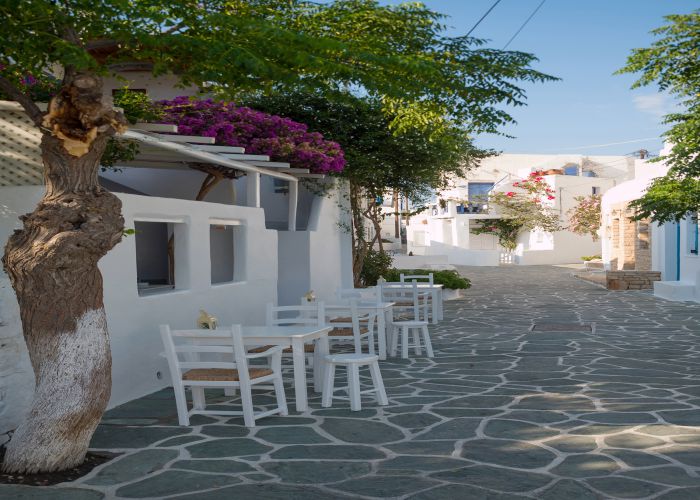
Being a part of the Cyclades complex, Milos Island has amazing Greek islands nearby that are worth a visit if you have the time.
Specifically, Milos is especially close to the islands of Kimolos, Sifnos, and Folegandros, making an island-hopping experience there an opportunity no one should pass upon.
The boat from Milos to the nearby island of Kimolos takes 20 minutes. From the moment the boat anchors in the port, you will come upon old windmills, cobbled streets, freshly whitewashed houses with blue windows, white chapels with blue domes, and a quietness that makes you want to whisper.
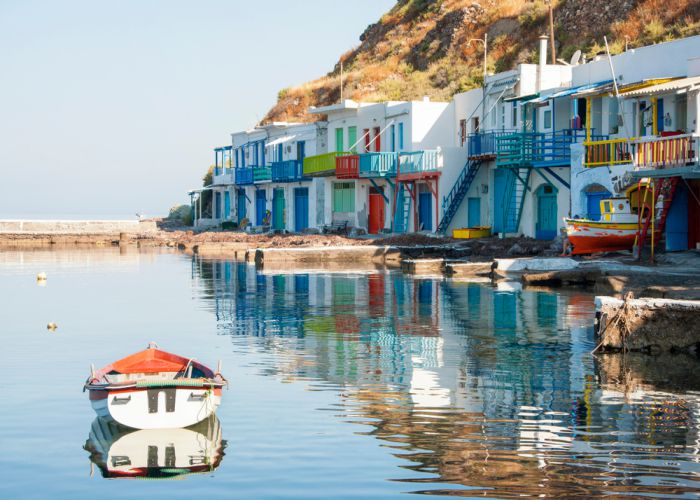
On top of all this, the walls of the medieval castle built in the 13th century, which protected the inhabitants of the island from pirate raids, stand as sleepless guards.
Away from the tourist crowds of other islands and with a rare serenity, Kimolos is a dreamy destination you will fall in love with.
What's more, Folegandros is another Greek island near Milos that will leave you breathless with its beauty like all other Cycladic islands. It is small and picturesque to the point that it looks fake and is increasingly popular.
Folegandros is an ideal destination for couples in love and fans of alternative tourism. You will not go to Folegandros to see the sights.
You will go for long walks in Ano Meria that reveal the other rural side of Folegandros, with the tree houses and the shrubs, but also for the local delicacies.
Last but not least, Sifnos is another one of the Greek islands that, despite not having gained the recognition it serves, is a sight for sore eyes and makes for the perfect short getaway from Milos.
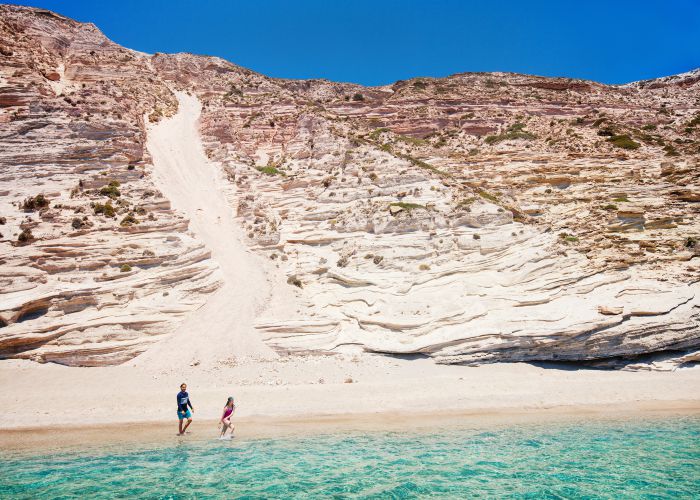
Sifnos has a disarming charm. It is a typical Cycladic canvas, with unpretentious elegance and a relaxed, zen character.
When you find yourself on the island, try to locate as many as you can from its 76 towers, plunge into the interior of the medieval Castle, and then surrender yourself to its villages that adorn opposite hillsides of the hinterland.
With neighboring islands like those, who can say no to island-hopping?
The Best Beaches in Milos, Greece
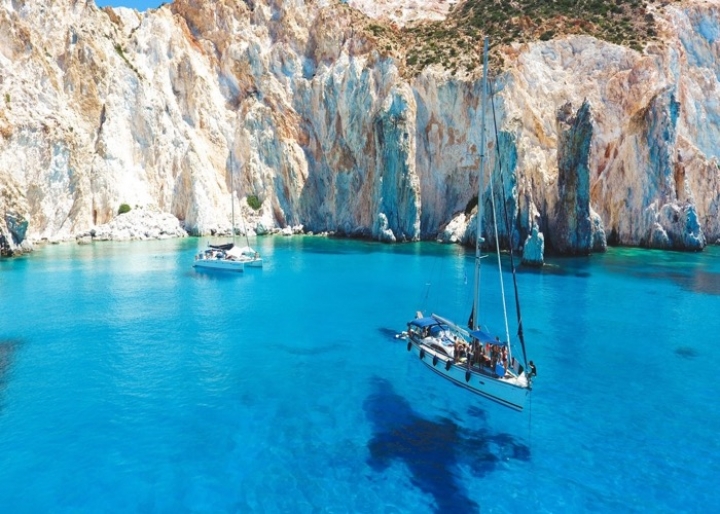
If you want your Greek island getaway to include Greek beaches and sea caves that look like they have been taken out from a fairytale, Milos is the place to be!
Milos Island, nestled in the heart of the Cyclades in Greece, is a treasure trove of natural beauty, and its beaches are among the most magnificent in the Aegean Sea.
With an array of diverse coastlines, from lunar landscapes to crystal-clear waters, Milos offers a beach experience for every type of traveler.
Here is an introduction to some of the best beaches that grace this enchanting island.
Sarakiniko Beach

Often likened to a moonscape, Sarakiniko Beach is one of Milos' most iconic and photographed spots.
The stark, white volcanic rocks curve smoothly around the beach, contrasting dramatically with the azure sea. This otherworldly beach provides a unique sunbathing experience on its smooth, chalky surfaces, and the clear waters are ideal for swimming and cliff diving.
Sarakiniko Beach lies on the northern coast of the island, and it is perhaps one of the most beautiful natural wonders of the Aegean Sea.
The area is named Sarakiniko because of its notorious past. During medieval times, this cove used to host many pirates that ravaged the coastline settlements of the island for years.
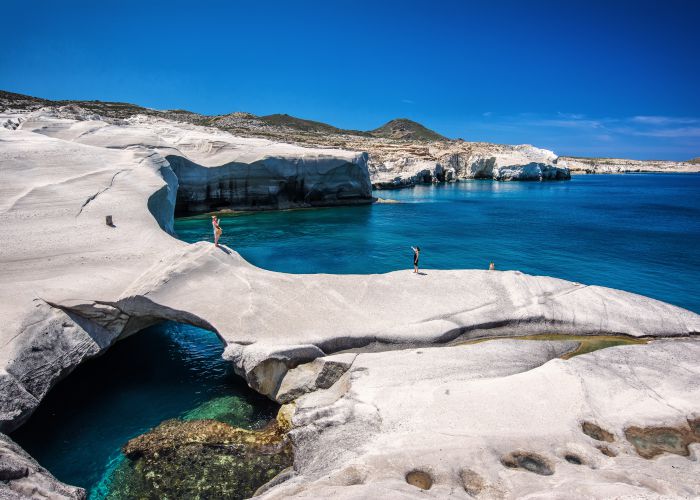
These white volcanic rocks are quite soft. Hence, people dug into the rock walls and created mazes of tunnels used for multiple purposes.
The whole area of Sarakiniko -including its sea caves- is protected as a natural landmark. Therefore, the beach is not organized with visitor facilities.
Today, the visitors reaching Sarakiniko Beach will be immediately amazed by the lunar scenery they will stumble upon, creating an eerie environment they will never forget!
Plan ahead, apply much sunblock, and enjoy your swim in the magical setting of Sarakiniko Beach.
Kastanas Beach
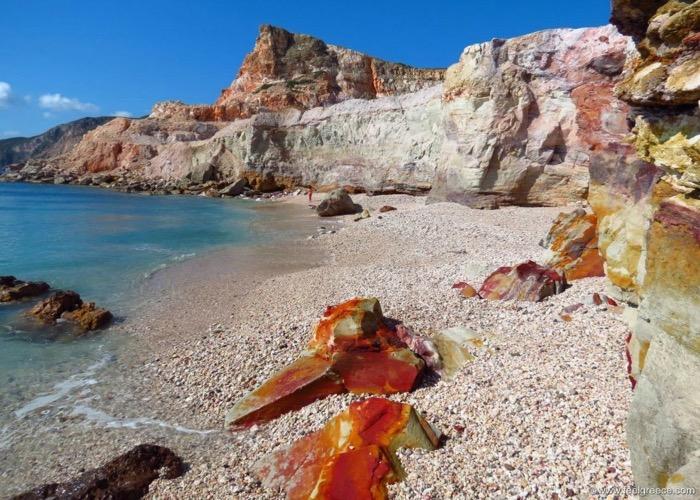
Kastanas beach lies on the eastern shores of Milos, close to the little port of Pollonia. Access to the beach is quite hard because of a narrow dirt road that crosses the hills of the area.
If you make it to the beach, you will find yourselves in a secluded cove with high cliffs surrounding you. Again, the geology of the island makes this place special.
Rocks of dark red, orange, white, and purple create a magical scenery, and in combination with the absence of people, the idyllic getaway is for relaxation and tranquility.
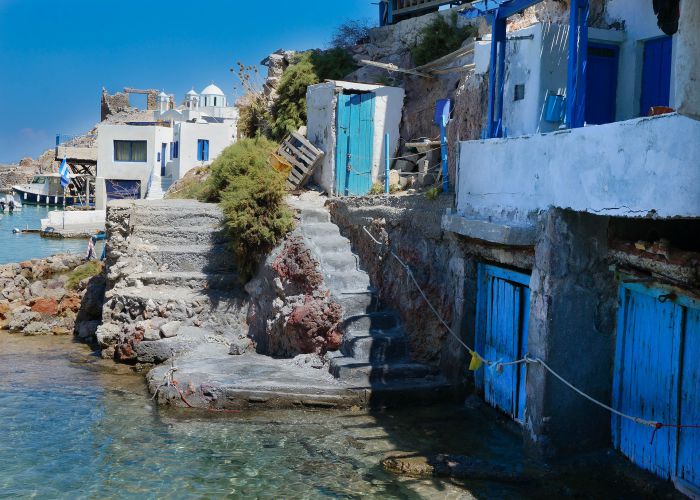
There are many smaller coves nearby for you to choose your own private beach as well. Kastanas is a favorite spot for nudists due to its seclusive character.
Lay on the pebbled beach of Kastanas and enjoy its cool, crystal-clear waters. There are no facilities at the site, so you'd better prepare accordingly before getting there.
Firiplaka Beach
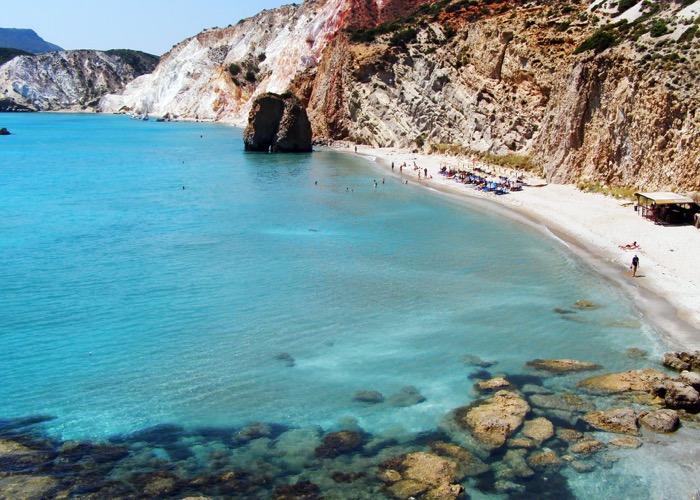
Firiplaka is located in the very south of Milos, and it is one of the most popular beaches on the island. It is a long white-sand beach with a dramatic backdrop of colorful volcanic cliffs, and a massive rock dividing it into two smaller ones.
The warm, shallow waters here are perfect for families, while the beach's southern end remains quieter, offering a serene spot for relaxation.
In case you are looking for a place where you can lie on a sunbed with a cool refreshment, surrounded by majestic scenery, this is the place to be. The beach is well-organized, with beach facilities and bars.
The crystal green-turquoise shallow waters of Firiplaka will enchant anyone who will try to swim in them. The natural setting of Firiplaka, combined with its soft sand and pebbles, creates a vibrant and inviting atmosphere.
Do not miss the chance to visit the nearby Tsigrado, a beach like a movie set but definitely for the more adventurous travelers.
Tsigrado Beach
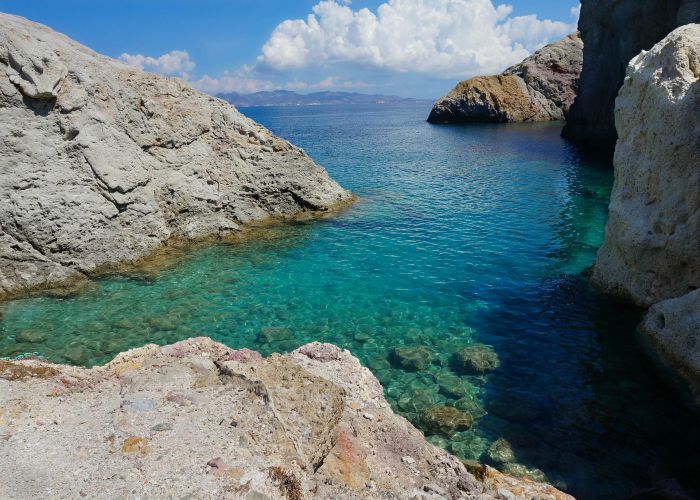
Tsigrado offers an adventure before you even set foot on its sands. To reach this secluded cove, visitors must navigate down a rocky path and ladder, a small challenge that ensures a rewarding experience.
The enclosed bay is surrounded by steep cliffs, providing shelter and a sense of seclusion. The clear, turquoise waters invite swimmers to plunge in and enjoy the tranquility of this hidden gem.
Papafragas Beach
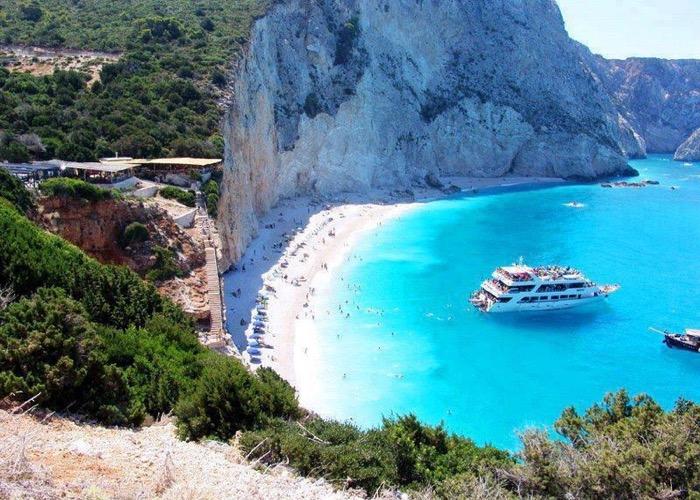
On your trip to Milos, there is no way you won't hear about Papafragas, a sandy beach so beautiful that you absolutely have to visit. Situated on the northeastern part of the island, it takes about 15 minutes by car to reach the beach from the port of Adamas.
It is only accessible on foot, and although the path that leads there is a bit difficult, it is definitely doable. If you make it to the beach, you will witness a narrow sea canal surrounded by high cliffs creating a spectacular setting.
Close to the tiny beach, on the walls of the cliffs, visitors have carved their initials while others have gone a step further, creating impressive reliefs.
Your experience in Papafragas will be memorable. Choose to visit the site in the evening and relax by watching a mesmerizing sunset.
Firopotamos Beach
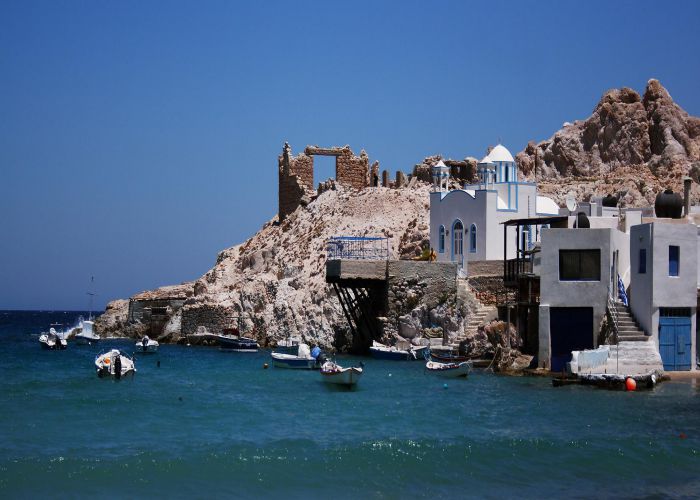
Firopotamos is a picturesque coastal village where traditional Cycladic architecture meets the sea.
The beach here is framed by charming fishermen's houses, a quaint church, and a small pier. While the pebbly shore and crystal waters are inviting, it's the authentic Greek ambiance and peaceful setting that makes Firopotamos a memorable stop for beachgoers seeking a quiet day by the sea.
Kleftiko Beach
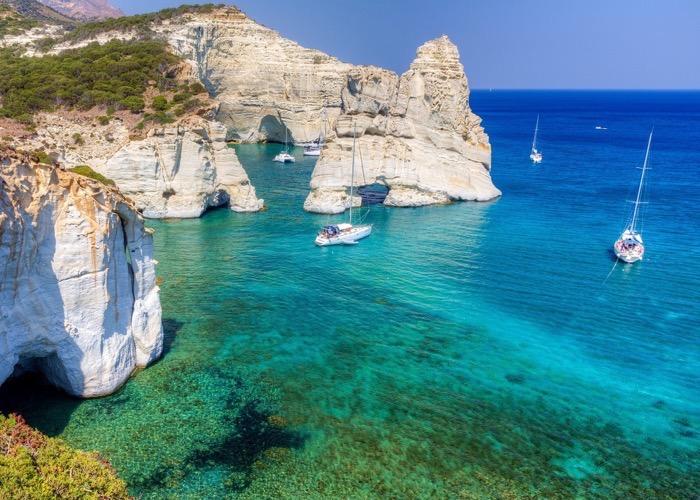
Accessible only by sea, Kleftiko Beach is an extraordinary testament to the island's volcanic heritage.
Known for its maze of towering sea stacks and hidden coves, Kleftiko was once a pirate hideout. Today, it's a paradise for explorers and snorkelers who can navigate the clear waters, discovering the rich marine life and captivating caves.
By being the trademark of the island, Kleftiko is the most iconic and popular beach on Milos Island.
Fortunately, at almost every port of Milos, you will find companies organizing the tour of the island by boat, stopping at Kleftiko.
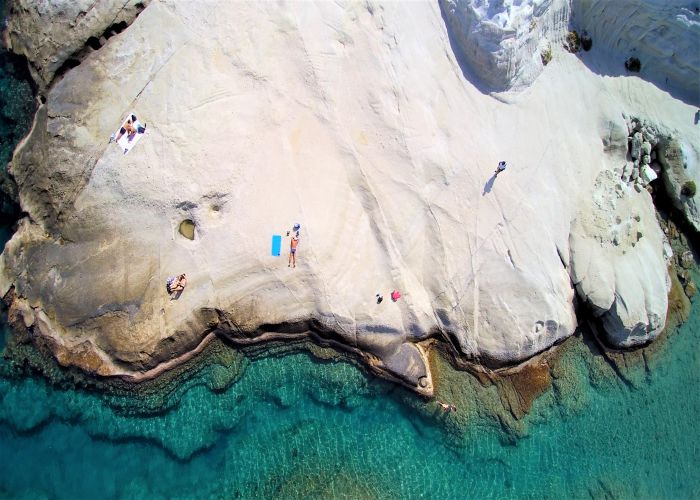
Kleftiko, with its huge white volcanic rocks, offers you the chance to swim in crystal-clear, turquoise waters surrounded by an impressive and unique landscape.
Do not miss the chance to visit the site, and if you're up for it, engage in a scuba diving activity that will allow you to explore the fascinating waters of southern Milos!
Best places to stay on Milos Island
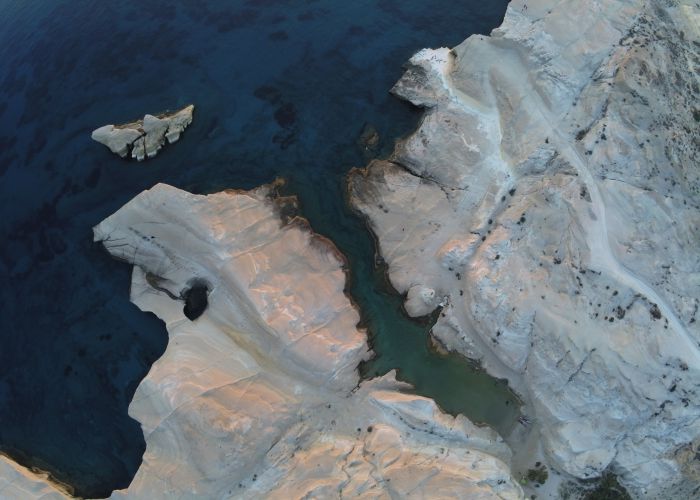
Milos, Greece - credits: cyprien delaporte/unsplash.com
Milos's tourist profile is newer than its long-time neighbor, Santorini. Regardless of that, it has a great tourist infrastructure with many high-end hotels scattered all around the island.
Depending on what type of vacation you're after, you can choose the best location for your accommodation. If you're looking for something central and cosmopolitan, a stay in Adamas, the main port town, is exactly what you're looking for.
The stay at Adamas is very convenient, with restaurants and shops adorning the streets and the port of departure being at your feet.
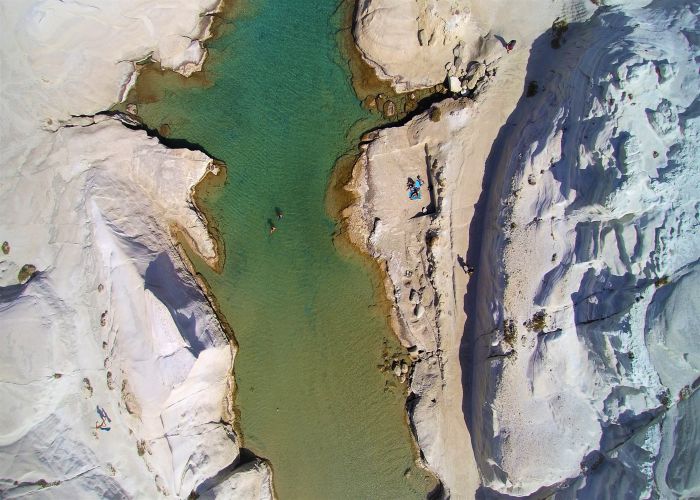
If you're looking for peace and quiet, you can stay in a fishing village or in one of the hotels the most famous and beautiful beaches of Milos boast.
You can check out our top selections of hotels in Milos.
How long do you need in Milos?
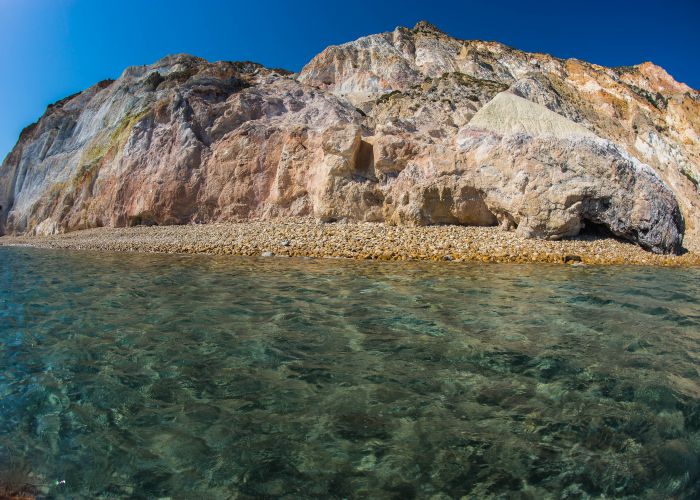
Milos is a rather large island, and despite its laid-back character, it has a lot of things for visitors to see. For that reason, the more days you spend on the island, the merrier.
In any case, you should try to spend no less than three days on Milos, as anything less than that will not allow you to get to know the island adequately, swim on its best beaches, and walk in a seaside town made of dreams.
Final Thoughts

Milos certainly is one of the most idyllic Greek islands of the Aegean Sea, with a natural heritage of spectacular beauty along with a vast history stretching for thousands of years.
It is a volcanic island of more than 80 diverse beaches, with each and every one of them being a gem that can be found nowhere else.
In case you want to have an unforgettable experience in Greece and want to marvel at a lunar landscape, plan your own trip to Milos or check out our handy Greek island hopping guide. Alternatively, book one of our Greece tours or Greece vacation packages to get introduced to Milos in the best way possible!
Frequently Asked Questions
Do I need a rental car on Milos?
Is Milos a party island?
What is Milos famous for?
How do you get to Milos Island?
Can you fly directly to Milos?





